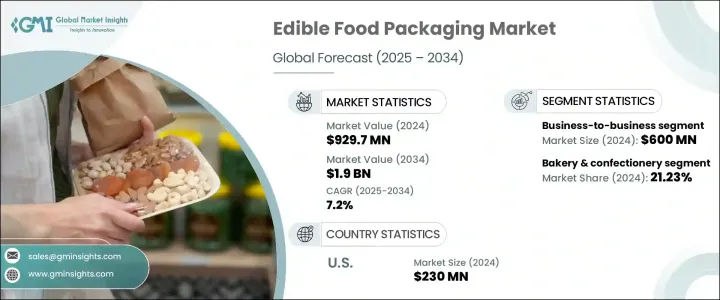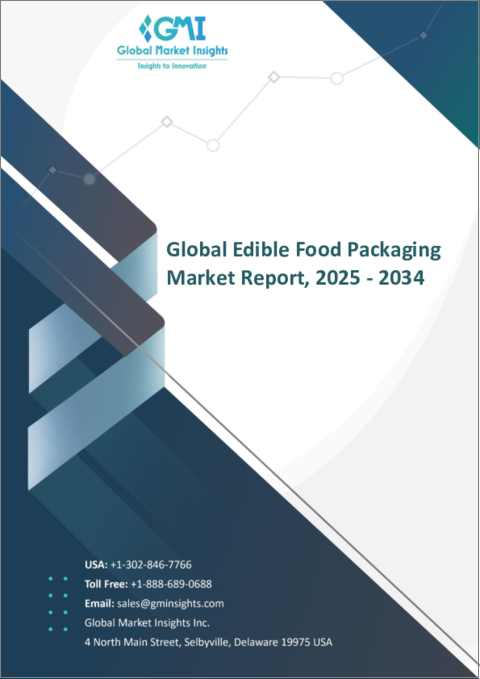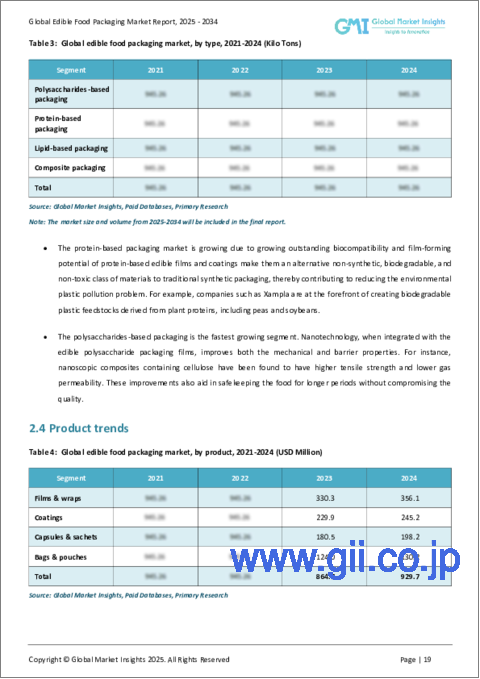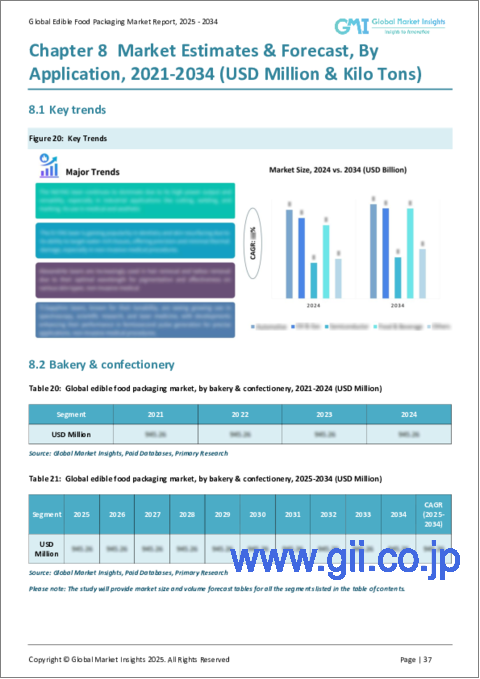|
|
市場調査レポート
商品コード
1721444
食用食品包装の市場機会、成長促進要因、産業動向分析と2025年~2034年予測Edible Food Packaging Market Opportunity, Growth Drivers, Industry Trend Analysis, and Forecast 2025 - 2034 |
||||||
カスタマイズ可能
|
|||||||
| 食用食品包装の市場機会、成長促進要因、産業動向分析と2025年~2034年予測 |
|
出版日: 2025年04月11日
発行: Global Market Insights Inc.
ページ情報: 英文 170 Pages
納期: 2~3営業日
|
全表示
- 概要
- 目次
食用食品包装の世界市場は、2024年には9億2,970万米ドルとなり、CAGR 7.2%で成長し、2034年には19億米ドルに達すると予測されています。
この市場は、消費者と産業界が同様に、より持続可能で環境に配慮した包装代替品へとシフトするにつれて、急速に勢いを増しています。プラスチック汚染や生態系への有害な影響に対する懸念の高まりは、廃棄物を最小限に抑えるだけでなく、健康やウェルネスの動向にも沿ったソリューションに対する需要を押し上げています。食用包装は、消費または堆肥化されるように設計されているため、埋立地や海洋への負担を軽減することができます。環境への意識がますます高まる中、この包装形態は持続可能な包装革命のフロントランナーとして台頭しつつあります。

市場の成長にはいくつかの重要な要因があります。最も強力な原動力のひとつは、環境と社会的責任をサポートする製品を優先する環境意識の高い消費者、特に若い層の台頭です。使い捨てプラスチックを取り締まる政府の政策も、世界の持続可能性の目標とともに、採用を加速させています。サーキュラー・エコノミーの原則が定着する中、食用パッケージは、廃棄物ゼロの実践や、海藻、デンプン、タンパク質ベースの化合物などの天然素材の革新的な利用を推進することで際立っています。ブランドは、機能的な要件を満たすだけでなく、美的感覚や倫理的価値観にも訴えるパッケージをデザインすることで対応しています。消費者が食品と地球の両方を保護する包装を求めるようになっているため、持続可能なソリューションで主要企業をリードする企業は市場シェアを拡大しています。
| 市場範囲 | |
|---|---|
| 開始年 | 2024 |
| 予測年 | 2025-2034 |
| 開始金額 | 9億2,970万米ドル |
| 予測金額 | 19億米ドル |
| CAGR | 7.2% |
食用食品包装は、性能と持続可能性の両方を実現する植物由来、堆肥化可能、生分解性素材の統合によって進化しています。2024年には、企業対消費者セグメントは3億3,000万米ドルに達し、日常食品における天然・有機包装への力強いシフトがその原動力となっています。スナック菓子や乳製品から飲食品、菓子類に至るまで、消費者は利便性や食品の安全性を犠牲にすることなくプラスチックを排除した包装を選ぶようになっています。環境問題に対する消費者の意識の高まりは、環境に優しい包装を多くの食品ブランドのセールスポイントに変えています。耐湿性や保存性といった機能的特性は、最新の食用包装ソリューションの標準となりつつあります。
ベーカリー・菓子類セグメントは2024年に21.23%の市場シェアを占めました。ベーカリー製品に使用される可食フィルムとコーティングは、風味、食感、製品の寿命を向上させるとともに、環境フットプリントを削減します。地元のベーカリーや食品小売業者は、持続可能性への取り組みの一環として、ペストリーやケーキなどの商品に食用ラップを採用しています。こうした変化は、より環境に優しい経営を奨励する地域のプログラムや外食政策によって支えられています。持続可能性が料理の技術革新の中心になるにつれ、食用包装の分野は職人や商業製パン業界全体で牽引力を増しています。
米国の食用食品包装市場は2024年に2億3,000万米ドルに達します。アメリカの消費者は、特にスナック菓子やスイーツにおいて、自然で健康志向の食材を使ったパッケージに傾倒しています。これらのソリューションは廃棄物を削減するだけでなく、栄養価も提供できます。気候を意識した選択が購買行動に影響を及ぼしており、従来のブランドと新興企業の両方が、環境に配慮した価値観と責任ある調達慣行に沿ったパッケージの革新にしのぎを削っています。
同市場の有力企業には、Tipa Corp Ltd.、Notpla Limited、TSUKIOKA FILM PHARMA CO.Ltd.、SIG Group、Evoware(PT. Evogaia Karya Indonesia)、WikiCell Designs Inc.各社は、保存期間が長く、耐湿性が強化されたバイオベースフィルムを開発するため、研究開発に投資しています。食品メーカーやハイテク企業との戦略的パートナーシップは、持続可能な生産規模の拡大に役立っています。消費者の信頼を築くために、認証や政府の支援を活用している企業も多いです。クリーンラベル、健康志向、廃棄物ゼロの動向を取り入れることで、ブランドは市場での確固たる地位を確立し、環境に配慮する購買層へのアピールを深めています。
目次
第1章 調査手法と範囲
第2章 エグゼクティブサマリー
第3章 業界考察
- エコシステム分析
- バリューチェーンに影響を与える要因
- 利益率分析
- ディスラプション
- 将来の展望
- 製造業者
- 販売代理店
- サプライヤーの情勢
- 利益率分析
- 主なニュースと取り組み
- 規制情勢
- 影響要因
- 促進要因
- 厳格な環境政策
- 政府および規制当局のインセンティブ
- 消費者の環境意識の高まり
- 循環型経済とゼロウェイストの理念との整合性
- 消費者体験の向上とブランドの差別化
- 業界の潜在的リスク&課題
- 極限条件下での耐久性
- スケーラビリティのための高い研究開発コスト
- 成長可能性分析
- ポーターの分析
- PESTEL分析
第4章 競合情勢
- イントロダクション
- 企業の市場シェア分析
- 競合ポジショニングマトリックス
- 戦略的展望マトリックス
第5章 市場推計・予測:タイプ別、2021-2034
- 主要動向
- 多糖類ベースの包装
- タンパク質ベースの包装
- 脂質ベースの包装
- 複合包装
第6章 市場推計・予測:製品別、2021-2034
- 主要動向
- フィルム&ラップ
- コーティング
- カプセルとサシェ
- バッグ&ポーチ
第7章 市場推計・予測:流通チャネル別、2021-2034
- 主要動向
- 企業間取引(B2B)
- 企業対消費者(B2C)
第8章 市場推計・予測:用途別、2021-2034
- 主要動向
- ベーカリー&菓子類
- 乳製品
- 肉、鶏肉、魚介類
- 果物と野菜
- すぐに食べられる食事
- 飲み物
- その他
第9章 市場推計・予測:地域別、2021-2034
- 主要動向
- 北米
- 米国
- カナダ
- 欧州
- 英国
- ドイツ
- フランス
- イタリア
- スペイン
- アジア太平洋地域
- 中国
- インド
- 日本
- 韓国
- オーストラリア・ニュージーランド
- ラテンアメリカ
- ブラジル
- メキシコ
- 中東・アフリカ
- アラブ首長国連邦
- サウジアラビア
- 南アフリカ
第10章 企業プロファイル
- Devro PLC
- Ecolotec
- Evoware(PT. Evogaia Karya Indonesia)
- FlexSea
- Glanbia PLC
- Lactips
- MonoSol LLC
- Mori(fka Cambridge Crops)
- Notpla Limited
- SIG Group
- Tipa Corp Ltd.
- TSUKIOKA FILM PHARMA CO. LTD.
- WikiCell Designs Inc.
The Global Edible Food Packaging Market was valued at USD 929.7 million in 2024 and is estimated to grow at a CAGR of 7.2% to reach USD 1.9 billion by 2034. This market is gaining rapid momentum as consumers and industries alike shift toward more sustainable and environmentally responsible packaging alternatives. Growing concerns about plastic pollution and its harmful impact on ecosystems are pushing demand for solutions that not only minimize waste but also align with health and wellness trends. Edible packaging offers a unique advantage in the sustainability movement-it's designed to be consumed or composted, reducing the burden on landfills and oceans. In a world increasingly driven by eco-awareness, this packaging form is emerging as a frontrunner in the sustainable packaging revolution.

Market growth is being fueled by several key factors. One of the strongest drivers is the rise of eco-conscious consumers, particularly among younger demographics who prioritize products that support environmental and social responsibility. Government policies cracking down on single-use plastics, along with global sustainability goals, are also accelerating adoption. As circular economy principles take hold, edible packaging stands out by promoting zero-waste practices and innovative use of natural materials such as seaweed, starch, and protein-based compounds. Brands are responding by designing packaging that not only meets functional requirements but also appeals to aesthetics and ethical values. Companies that lead with sustainable solutions are gaining market share as shoppers increasingly expect packaging that protects both food and the planet.
| Market Scope | |
|---|---|
| Start Year | 2024 |
| Forecast Year | 2025-2034 |
| Start Value | $929.7 Million |
| Forecast Value | $1.9 Billion |
| CAGR | 7.2% |
Edible food packaging is evolving through the integration of plant-based, compostable, and biodegradable materials that deliver on both performance and sustainability. In 2024, the business-to-consumer segment reached USD 330 million, driven by a strong shift toward natural and organic packaging in everyday food products. From snacks and dairy to beverages and confectionery, consumers are opting for packaging that eliminates plastic without sacrificing convenience or food safety. Growing public awareness of environmental issues is turning eco-friendly packaging into a selling point for many food brands. Functional attributes such as moisture resistance and shelf-life preservation are becoming standard in modern edible packaging solutions.
The bakery and confectionery segment accounted for a 21.23% market share in 2024. Edible films and coatings used in baked goods enhance flavor, texture, and product longevity while reducing the environmental footprint. Local bakeries and food retailers are embracing edible wraps in items like pastries and cakes as part of their sustainability efforts. These changes are supported by local programs and food service policies encouraging greener operations. As sustainability becomes central to culinary innovation, the edible packaging space is gaining traction across artisanal and commercial baking industries.
The U.S. Edible Food Packaging Market reached USD 230 million in 2024. American consumers are leaning toward packaging made from natural, health-forward ingredients, particularly in snacks and sweets. These solutions not only cut down on waste but can also deliver nutritional value. Climate-conscious choices are influencing buying behavior, and both legacy brands and startups are racing to innovate with packaging that aligns with green values and responsible sourcing practices.
Prominent players in the market include Tipa Corp Ltd., Notpla Limited, TSUKIOKA FILM PHARMA CO. LTD., SIG Group, Evoware (PT. Evogaia Karya Indonesia), and WikiCell Designs Inc. Companies are investing in R&D to create bio-based films with longer shelf life and enhanced moisture resistance. Strategic partnerships with food producers and tech firms are helping scale production sustainably. Many are leveraging certifications and government support to build consumer trust. By embracing clean-label, health-conscious, and zero-waste trends, brands are establishing strong market positions and deepening their appeal to green-minded buyers.
Table of Contents
Chapter 1 Methodology & Scope
- 1.1 Market scope & definitions
- 1.2 Base estimates & calculations
- 1.3 Forecast calculations
- 1.4 Data sources
- 1.4.1 Primary
- 1.4.2 Secondary
- 1.4.2.1 Paid sources
- 1.4.2.2 Public sources
Chapter 2 Executive Summary
- 2.1 Industry synopsis, 2021-2034
Chapter 3 Industry Insights
- 3.1 Industry ecosystem analysis
- 3.1.1 Factor affecting the value chain
- 3.1.2 Profit margin analysis
- 3.1.3 Disruptions
- 3.1.4 Future outlook
- 3.1.5 Manufacturers
- 3.1.6 Distributors
- 3.2 Supplier landscape
- 3.3 Profit margin analysis
- 3.4 Key news & initiatives
- 3.5 Regulatory landscape
- 3.6 Impact forces
- 3.7 Growth drivers
- 3.7.1 Stringent environmental policies
- 3.7.2 Government & regulatory incentives
- 3.7.3 Growing consumer eco-consciousness
- 3.7.4 Alignment with circular economy and zero-waste ideals
- 3.7.5 Enhanced consumer experience & brand differentiation
- 3.8 Industry pitfalls & challenges
- 3.8.1 Durability under extreme conditions
- 3.8.2 High r&d costs for scalability
- 3.9 Growth potential analysis
- 3.10 Porter’s analysis
- 3.11 PESTEL analysis
Chapter 4 Competitive Landscape, 2024
- 4.1 Introduction
- 4.2 Company market share analysis
- 4.3 Competitive positioning matrix
- 4.4 Strategic outlook matrix
Chapter 5 Market Estimates & Forecast, By Type, 2021-2034 (USD Million & Kilotons)
- 5.1 Key trends
- 5.2 Polysaccharides-based packaging
- 5.3 Protein-based packaging
- 5.4 Lipid-based packaging
- 5.5 Composite packaging
Chapter 6 Market Estimates & Forecast, By Product, 2021-2034 (USD Million & Kilotons)
- 6.1 Key trends
- 6.2 Films & wraps
- 6.3 Coatings
- 6.4 Capsules & sachets
- 6.5 Bags & pouches
Chapter 7 Market Estimates & Forecast, By Distribution Channel, 2021-2034 (USD Million & Kilotons)
- 7.1 Key trends
- 7.2 Business-to-business (B2B)
- 7.3 Business-to-consumer (B2C)
Chapter 8 Market Estimates & Forecast, By Application, 2021-2034 (USD Million & Kilotons)
- 8.1 Key trends
- 8.2 Bakery & confectionery
- 8.3 Dairy products
- 8.4 Meat, poultry, and seafood
- 8.5 Fruits & vegetables
- 8.6 Ready-to-eat meals
- 8.7 Beverages
- 8.8 Others
Chapter 9 Market Estimates & Forecast, By Region, 2021-2034 (USD Million)
- 9.1 Key trends
- 9.2 North America
- 9.2.1 U.S.
- 9.2.2 Canada
- 9.3 Europe
- 9.3.1 UK
- 9.3.2 Germany
- 9.3.3 France
- 9.3.4 Italy
- 9.3.5 Spain
- 9.4 Asia Pacific
- 9.4.1 China
- 9.4.2 India
- 9.4.3 Japan
- 9.4.4 South Korea
- 9.4.5 ANZ
- 9.5 Latin America
- 9.5.1 Brazil
- 9.5.2 Mexico
- 9.6 MEA
- 9.6.1 UAE
- 9.6.2 Saudi Arabia
- 9.6.3 South Africa
Chapter 10 Company Profiles
- 10.1 Devro PLC
- 10.2 Ecolotec
- 10.3 Evoware (PT. Evogaia Karya Indonesia)
- 10.4 FlexSea
- 10.5 Glanbia PLC
- 10.6 Lactips
- 10.7 MonoSol LLC
- 10.8 Mori (fka Cambridge Crops)
- 10.9 Notpla Limited
- 10.10 SIG Group
- 10.11 Tipa Corp Ltd.
- 10.12 TSUKIOKA FILM PHARMA CO. LTD.
- 10.13 WikiCell Designs Inc.






